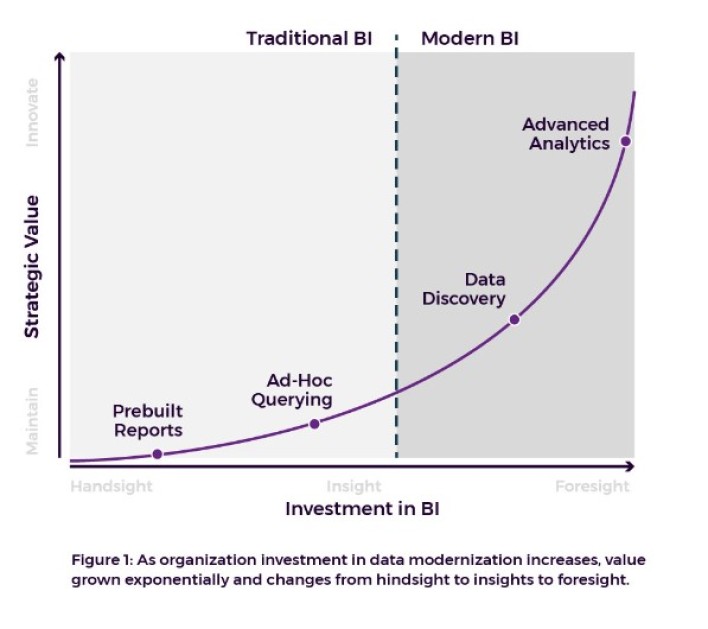Blog / Leadership & Transformation
Data storytelling is the new language of future-fit organisations
Categories

Transformation of traditional Business Intelligence to modern Business Intelligence enables businesses to democratise data and engage the organisation cross functionally to enhance business decisions to create a bigger impact on the bottom line.
Business Intelligence isn’t new but the way it is gathered and analysed is changing rapidly. There is more pressure to gain insights to drive value and improve efficiencies across complex, multiple data sources, including sensors, in real time. Traditional business intelligence was delivered to senior executives by IT and provided hindsight.
Modern business intelligence can provide foresight into what is happening, what will happen and why. With proper tools and software, processes and change management, organisations can become more agile and efficient, harnessing the power of data to become forward-looking, offering the ability to not only obtain and monitor a pulse of the organization through rapid analytics, but to accomplish objectives through predictive analytics.

Modern business intelligence platforms help organizations take advantage of huge amounts of existing and new information. Organizations don’t have to replace their existing data platforms but can leverage existing tools and expand capabilities by augmenting modern technologies.
The modern BI environment provides a foundation of data source integration, sophisticated analytical models and techniques and an easy-to-use, intuitive interface with auto-suggestions and recommendations for analytical techniques and report formats and publishing tools, alerts and analysis sharing that are easy to adopt by the average business user.
A modern platform can co-exist in a traditional BI reporting environment to extend the capabilities of data exploration, advanced analytics and predictive analytics to create a future-fit organisation. Organizations looking to modernize their analytics platforms are implementing data lakes. Data lakes offer a low-cost solution for efficiently storing and analysing many types of data in native form. A data lake solution coupled with a data warehouse defines the next generation of BI and offers an optimal foundation for data analysis.
Accelerated cloud data migration is fuelling modern BI adoption
When modernizing a data strategy, moving data to the cloud because of added flexibility and scalability at a lower total cost of ownership is critical. As data moves to the cloud at an accelerated rate, analytics will naturally follow because of “data gravity”. The cloud makes it easier for companies to capture and integrate different types of data. This means moving away from an environment where all data resides in a highly-structured, on-premises warehouse and into a more scalable, flexible infrastructure - either a full-cloud or hybrid solution.
Visualisation and data storytelling is the new way of communicating business intelligence
No matter how automated, how smart the analysis and the insights - if the findings cannot be communicated simply, clearly and effectively, it is worthless. Data visualization is a powerful language and it’s becoming standard to convey information to decision makers in a way that is actionable and easy to understand. This skill, combined with the ability to share the methodology taken to discover the insights in data, is often defined as “data storytelling.” Future-fit organisations are fostering data literacy aimed at teaching people to truly understand the data and to be participants in the analytical conversation - from the moment of discovery to the resulting business decisions.
Empowering Staff to make insight-driven decisions requires a training foundation and a culture conducive for continuous learning
The assumption that everyone is getting value out of a BI platform just because they have access to it is a misnomer. Leaders should focus on whether or not data and analytics are changing the way that decisions are made throughout the organization. If one took the BI platform away from employees, would it impact the way they make day to day decisions?
The majority of the team need to be able to use data and create narratives to support initiatives or make improvements on a daily basis as a matter of course. Hands-on training sessions, deep dives, and ongoing support should be available to potential users. By fostering interest through interactive workshops, office-specific demos, and clear means of communication, effective data management can keep users active and interested, spread awareness, and preserve the momentum once the technical transition itself is complete.
JPMorgan Chase’s centre of excellence team hold full-day sessions - what Steven Hittle, Vice President and BI Innovation Leader, refers to as “data therapy sessions” - to share data visualization and governance best practices. These sessions are just one of many activities used to spark the engagement and conversation between roles and departments that helped JPMC scale its modern BI platform to over 30,000 people.
Conclusion
There is no reason to operate the process by instinct or intuition – future-fit organisations are building core capabilities around data-centricity and gaining momentum ahead of competitors one insight implemented at a time. Enterprises are getting smarter and smarter at analytics adoption, natural language humanisation of data and data collaborations for good.
If you want to future-proof you career, get a comprehensive understanding of data management and analysis, and change the way you look at business strategies, then enrol in ZIGURAT's Global MBA in Digital Transformation.





